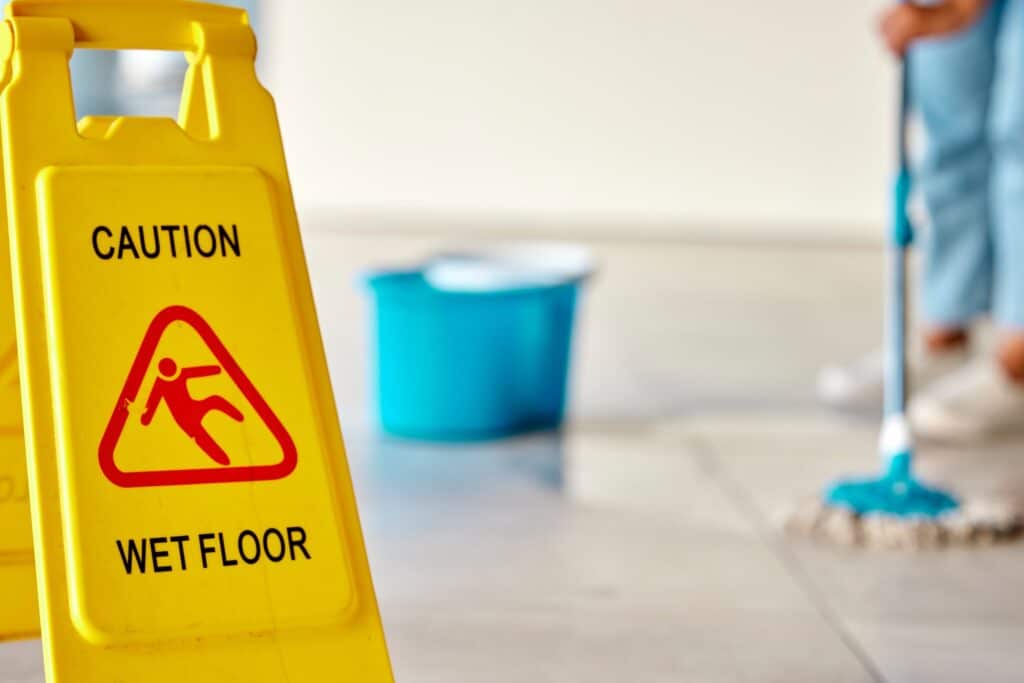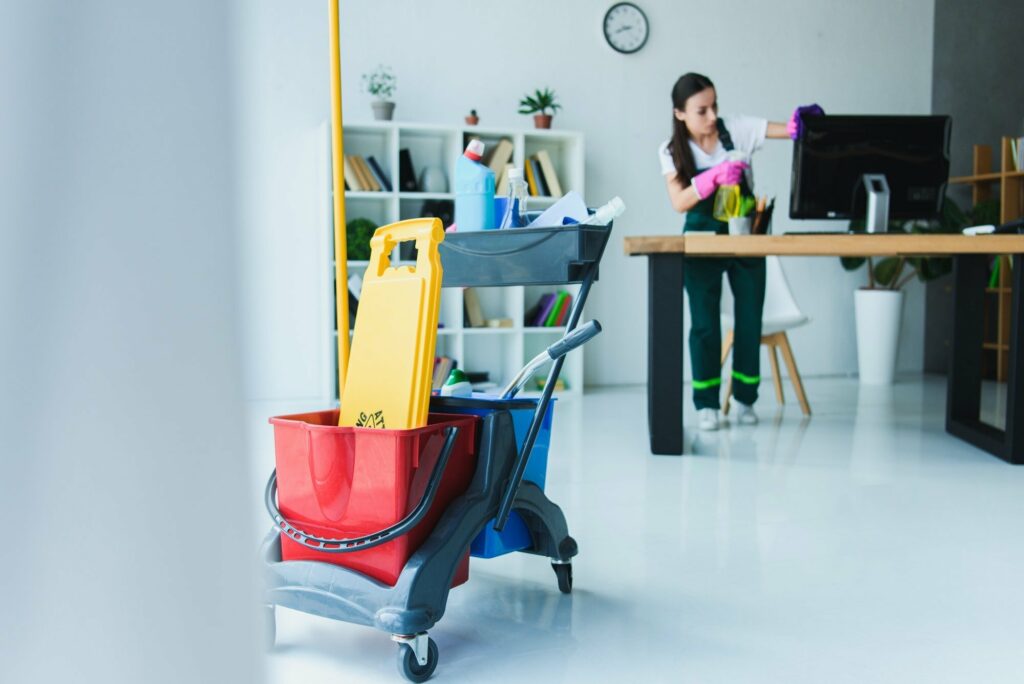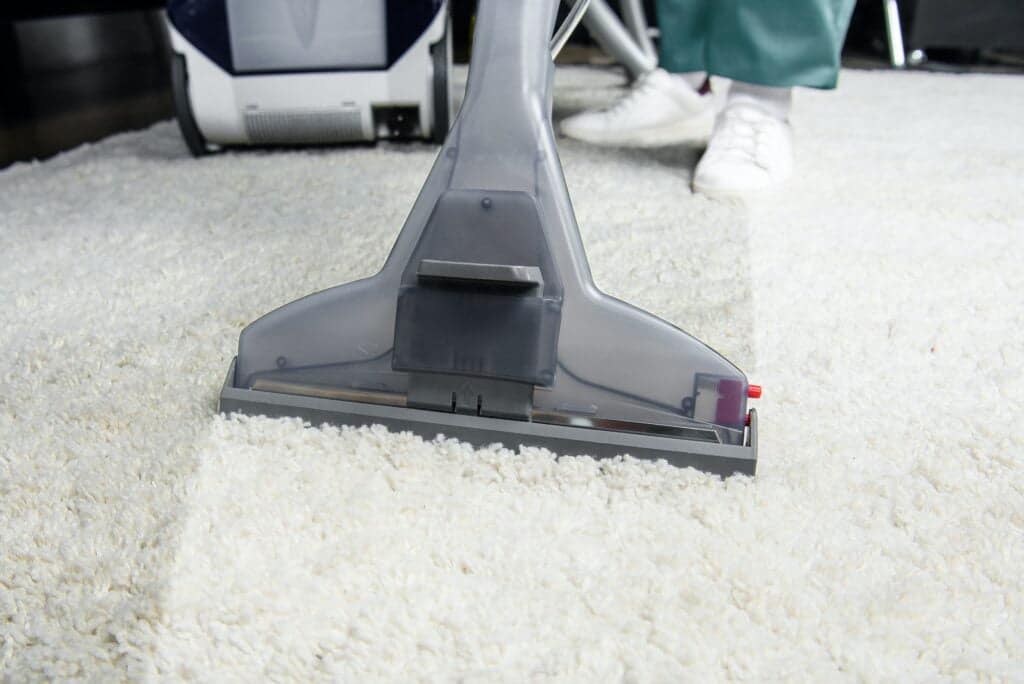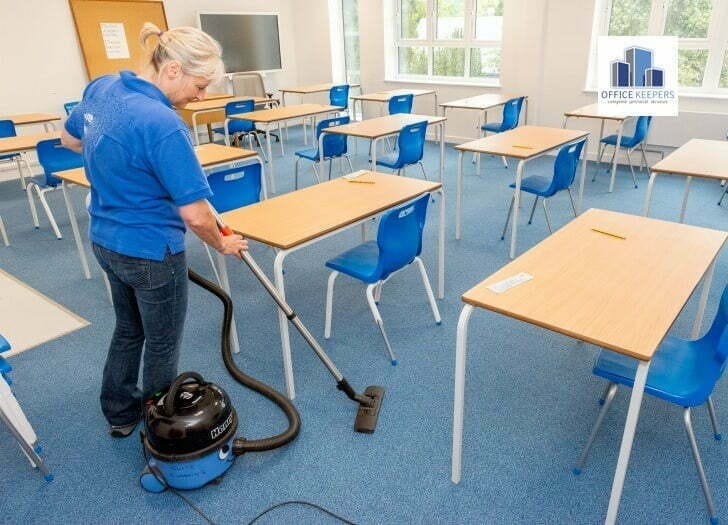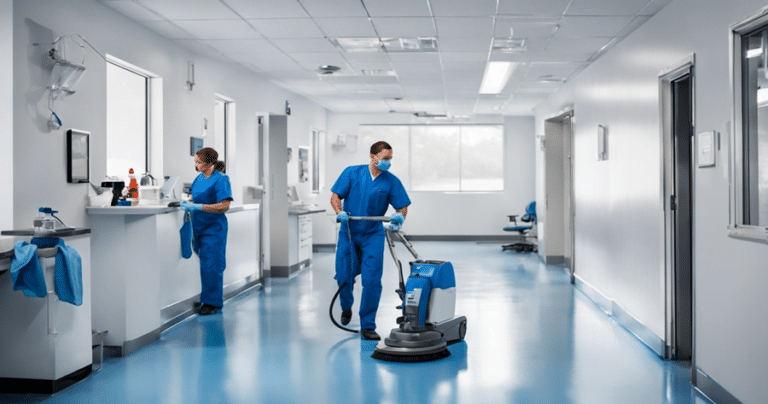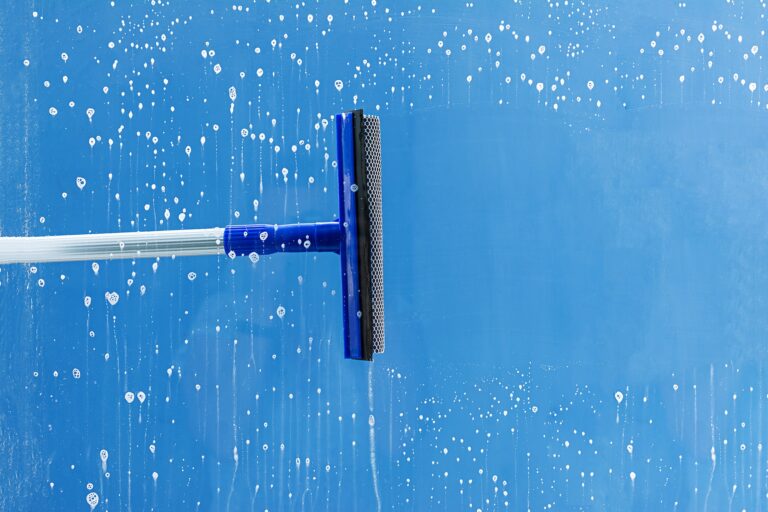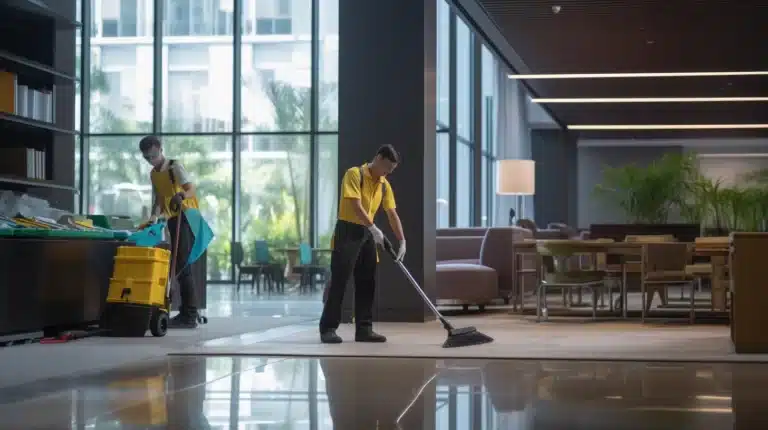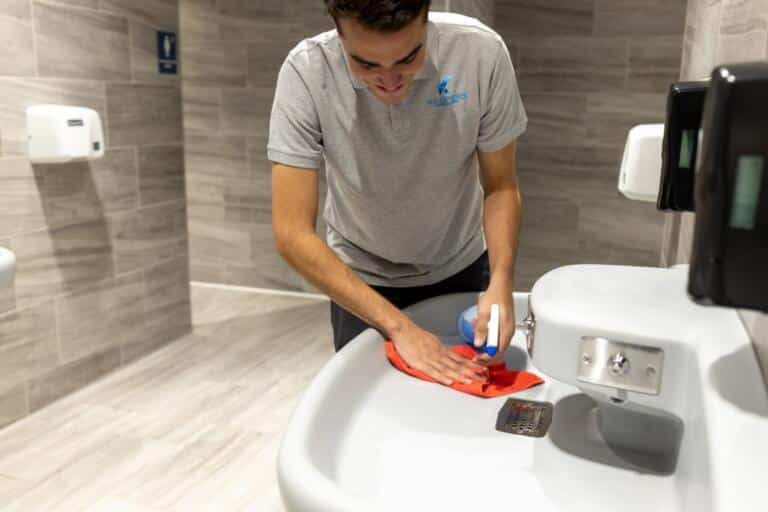A clean warehouse isn’t just about appearances. Your machinery is the engine room of your industrial facility, and the condition of these facilities can directly influence productivity levels in your office. When the cleaning duties are carried out efficiently using a sanitation checklist, workers find the cleaning process results in a healthier, safer, and more productive workspace. The quality of your stock product remains high and well-preserved in our warehouses and facility. Plus, let’s not forget: a well-organized warehouse facility, with a properly managed inventory and competent staff, is a visual testament to your company’s standards when visitors drop by. So, how about we dive into some practical tips that will help keep your warehouse facility clean and your operations running smoothly? From the use of vacuums to the efficient deployment of your staff, let’s explore. Get ready to discover how cleanliness in your company’s facility, maintained by diligent employees using vacuums, can be more than next to godliness—it could be the key to elevating your business performance.
Effective Warehouse Space Organization
Layout Design’s Role in Cleaning
Ever looked at warehouses and thought, “Man, this place is a mess”? Could vacuums and employees help? That’s where layout design comes into play. It’s like a game of Tetris. You’ve got to fit all your items into the warehouse space, where employees use vacuums to keep things neat and tidy.
Consider this: if your items on the warehouse shelves are haphazardly placed, cleaning with vacuums becomes a Herculean task, even with help. But with an efficient layout in your warehouses, employees can easily maneuver around with their vacuums and other cleaning equipment to maintain items. You’re not just creating an organized industrial facility with well-arranged items; you’re also making life easier for your employees, the clean-up crew.
Implementing a Warehouse Cleaning Process
Warehouse cleaning isn’t just about sweeping the floor. It’s a systematic process that requires careful planning, training, and auditing for employees.
Establishing SOPs for Cleaning Tasks
First things first, you’ve got to establish some standard operating procedures (SOPs) for your employees’ warehouse cleaning tasks. Think of these as your game plan. They outline exactly how each task should be performed, from dusting off raw materials to mopping up spills.
- Define responsibilities: Who’s in charge of what? Make it clear.
- Specify cleaning methods: Which techniques work best for different areas?
- Detail safety measures: How can workers protect themselves during the process?
These SOPs won’t just keep your warehouse spick-and-span; they’ll also ensure everyone’s on the same page.
Training Staff on SOP Execution
Now that you’ve got your SOPs sorted out, it’s time to train your team. This ain’t no ordinary broom-pushing gig; proper warehouse sanitation is a skill that needs to be learned.
Hold regular training sessions where employees can:
- Learn about the importance of cleanliness in a warehouse setting
- Understand how to execute each SOP effectively
- Get hands-on practice with various cleaning tasks
Remember, knowledge is power!
Regular Audits for Compliance
You’ve set the rules and trained the team – but are they following through? That’s where regular audits come into play.
Conduct routine checks to ensure:
- Compliance with SOPs
- Proper use of cleaning tools and equipment
- Adherence to safety measures
Audits aren’t meant to catch people out; they’re there to keep standards high and maintain a clean warehouse environment.
Continuous Improvement Approach
Finally, don’t get complacent! Keep an eye out for new ways to improve your warehouse cleaning process. Maybe there’s a more efficient tool you could use or perhaps a certain SOP needs tweaking.
- Gather feedback from staff: They’re the ones on the front line, after all.
- Stay updated with industry best practices: There’s always something new to learn.
- Implement changes gradually: Rome wasn’t built in a day!
Key Cleaning Tasks and How-to’s
Let’s dive into the nitty-gritty of warehouse cleaning. We’ll cover sweeping techniques, heavy-duty cleanup, detergents, sanitizers, and regular equipment checks.
Proper Sweeping Techniques
Hey there! Ever swept your floor only to find a cloud of dust rising? That’s what we want to avoid in a warehouse. To minimize dust dispersal, you gotta sweep slow and steady.
- Start from one end of the space.
- Sweep towards the other end with gentle strokes.
- Collect the debris in a dustpan regularly.
Remember, it ain’t a race. The goal is clean floors without choking on dust.
Industrial Vacuums for Heavy-Duty Cleanup
Sometimes brooms just won’t cut it. You need more power! That’s where industrial vacuums come into play.
- Identify areas needing heavy-duty cleanup.
- Use an industrial vacuum cleaner designed for large debris.
- Dispose of collected waste safely.
These bad boys can suck up everything from metal shards to wood chips!
Correct Use of Detergents and Sanitizers
Not all areas are created equal. Some spots need detergents; others require sanitizers.
- High-touch surfaces: Door handles or control panels need sanitizing wipes or sprays.
- Floors: A good ol’ mop paired with a strong detergent does wonders here.
Always remember to read the instructions before using any cleaning product!
Regular Equipment Maintenance Checks
Last but definitely not least – regular checks on your cleaning equipment are crucial! It’s like taking your car for servicing; you wouldn’t want it breaking down mid-journey, right?
- Check filters in vacuum cleaners regularly.
- Inspect brooms for worn-out bristles.
- Ensure mops are clean before use.
Regular equipment maintenance will keep your tools working longer and more effectively.
Best Practices for Waste Disposal
Waste disposal can be a real headache in a warehouse setting. But, hey, no worries! I’ve got some top-notch tips to help you handle your waste like a pro.
Segregate Recycle and Dispose Safely
First off, let’s talk about segregation. You know how we separate the whites from the colors when doing laundry? The same principle applies here.
- Dump your garbage into different bins: one for recyclables (think paper and plastic wrap), another for general waste (like food scraps), and maybe one more for hazardous materials.
- Make sure you’re disposing of hazardous stuff properly. We don’t want any accidents!
Location Matters For Bins
Next up is where to place these garbage bins. It’s not rocket science, but it does need some thought.
- Keep them near high traffic areas or places where most of the trash is generated.
- Avoid blocking exits or pathways with your bins – safety first!
Regular Collection and Disposal
Now, onto scheduling waste collection and disposal services. It’s kinda like taking out the trash at home, just on a larger scale.
- Set up regular pickups with your local waste management company.
- Don’t let that garbage pile up – it’s not only unsightly but can also pose health hazards.
Comply With Environmental Regulations
Lastly, always keep an eye on environmental regulations regarding waste management. Think of it as staying on the right side of Mother Nature (and avoiding hefty fines!).
- Stay updated with local laws about proper waste disposal.
- Implement eco-friendly practices whenever possible – reduce, reuse, recycle!
The Role of Ergonomic Cleaning Equipment
Ergonomic cleaning tools are game-changers in warehouse maintenance. They not only reduce worker fatigue but also boost efficiency, lower injury risks, and save costs.
Worker Fatigue Reduction
Ever worked a long shift and felt like your arms were about to fall off? Yeah, that’s what traditional cleaning equipment can do. But ergonomic tools? They’re the real MVPs. Designed with you in mind, they make cleaning tasks less of a hassle and more of a breeze.
For instance, an ergonomic mop handle is typically lightweight and adjustable to fit your height perfectly. No more bending over or straining your muscles just to get that stubborn dirt off the floor!
Efficiency on Steroids
Next up is efficiency. Imagine trying to clean a massive warehouse with a tiny broom – sounds like a nightmare, right? Well, user-friendly equipment designs come through big time here.
Take industrial vacuum cleaners for example. These bad boys have powerful suction capabilities and large dust capacities which mean fewer trips to the trash bin for emptying. Plus, they often come with wide cleaning paths that cover more ground in less time.
Lower Injury Risks
Repetitive motions or heavy lifting during cleaning tasks can be brutal on your body over time. But ergonomic equipment can help keep those nasty injuries at bay.
Consider an automatic scrubber-drier machine that does all the hard work so you don’t have to bend or kneel repeatedly while scrubbing floors manually. Or how about using trolleys for transporting heavy bins instead of carrying them yourself?
Cost Savings Galore
Lastly, let’s talk moolah! High-quality cleaning equipment might cost you upfront but think about it this way – they last longer than their cheaper counterparts. You won’t have to replace them as often which translates into big-time savings in the long run.
Plus, if workers are less tired and more efficient, they’re likely to make fewer mistakes that could lead to costly damages in the warehouse. Not to mention, lower injury risks mean less downtime and medical expenses.
Scheduling and Maintaining Regular Cleanliness
Crafting a Cleaning Task List
Keeping a warehouse clean isn’t just about picking up a broom once in a while. It’s all about organizing cleaning duties into daily, weekly, and monthly tasks based on priority areas.
For instance, high traffic areas like breakrooms might need daily attention. Meanwhile, less frequented spots could be scheduled for weekly or monthly cleaning. This way, no corner of the warehouse gets overlooked.
- Daily tasks: Sweeping floors, sanitizing work surfaces
- Weekly tasks: Dusting shelves, disinfecting equipment
- Monthly tasks: Deep-cleaning restrooms, checking sanitation checklist
Harnessing Digital Tools
In this digital age, why not let technology lend us a hand? Use digital tools or software to track your scheduled cleaning effectively. These tools can send reminders when it’s time to dust off those shelves or sweep the floors.
Plus, they can help you keep an eye on the progress of cleaning duties without having to do physical checks constantly. Talk about working smart!
Building in Flexibility
Let’s face it; messes don’t always stick to our plan! So it’s essential to incorporate flexibility in schedules for unexpected cleaning needs.
Maybe there was an accidental spillage that needs immediate attention? Or perhaps the breakroom is dirtier than usual after a busy day? Having some wiggle room in your schedule ensures these surprise messes are taken care of promptly.
Regular Inspections Are Key
Finally yet importantly, regular inspections play a crucial role in maintaining cleanliness standards. They allow you to spot any missed spots and ensure that all areas are sanitized properly.
Think of them as your safety net against germs lurking around! Plus they give you peace of mind knowing your warehouse is spick and span.
Emphasizing Clean Warehouse Benefits
Keeping your warehouse spick and span isn’t just about making it look pretty. It’s about creating a safer, more efficient work environment that can boost productivity and save you some serious dough in the long run. From organizing your space to scheduling regular cleanups, every step counts in maintaining cleanliness. And hey, don’t forget the role of ergonomic cleaning equipment! They’re like the superheroes of warehouse cleaning – getting into those hard-to-reach places and fighting off dust and grime.
Now that you’ve got these tips up your sleeve, it’s time to roll up those sleeves and get down to business. Remember, a clean warehouse is a happy warehouse! So why not start implementing these strategies today? Your warehouse will thank you for it!
FAQs
How often should I schedule warehouse cleaning?
The frequency of cleaning depends on the nature of your operations but generally, daily cleanup tasks with thorough weekly or monthly cleanings are recommended.
What type of cleaning equipment is best for warehouses?
Ergonomic cleaning equipment such as industrial sweepers and scrubbers are ideal for warehouses due to their efficiency in covering large areas.
How does a clean warehouse improve efficiency?
A clean warehouse reduces clutter which improves mobility and reduces time wasted on searching for items. It also minimizes accidents resulting from slips or falls.
Is professional help needed for warehouse cleaning?
While small daily tasks can be handled by staff, professional cleaners may be needed for thorough deep-cleaning sessions especially in larger warehouses.
Can waste disposal practices affect my warehouse’s cleanliness?
Absolutely! Proper waste disposal prevents accumulation of garbage which could attract pests or cause foul odors.
Does organizing my warehouse contribute to its cleanliness?
Yes, an organized warehouse allows easier access to items which helps maintain orderliness thus reducing cluttering which contributes significantly to cleanliness.
How can I motivate my staff to maintain warehouse cleanliness?
Incentivizing cleanliness, making it part of the work culture and leading by example are effective ways to encourage your team to keep the warehouse clean.

